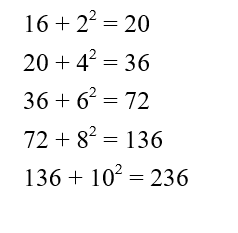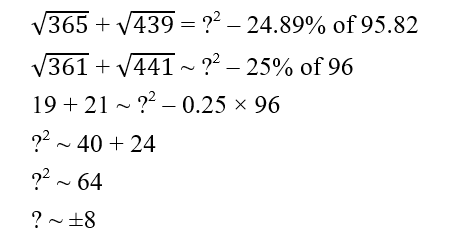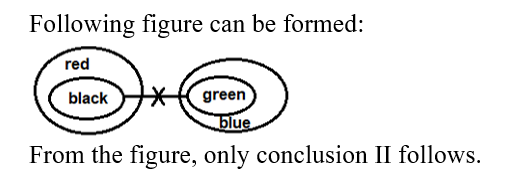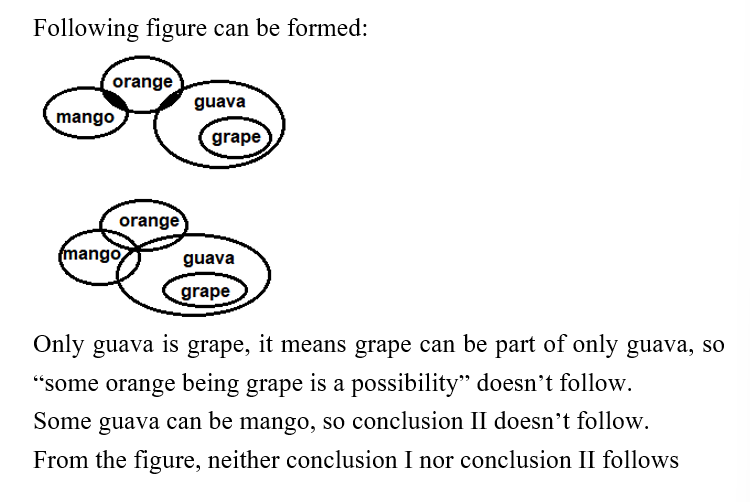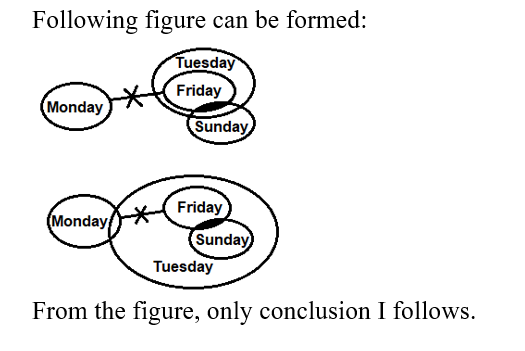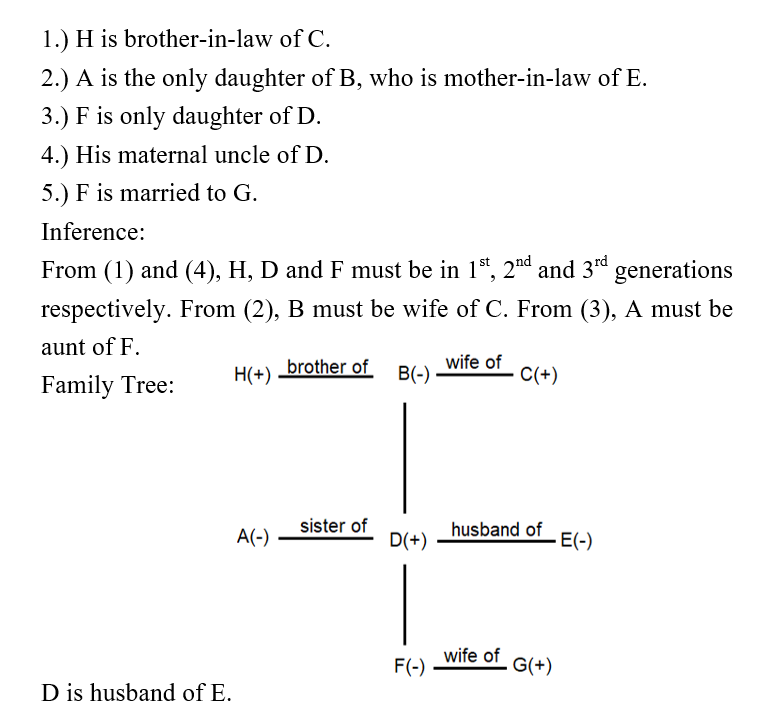Question 1:
Direction: What will come in place of the question mark (?) in the following series?
निर्देश: निम्नलिखित श्रृंखला में प्रश्नवाचक चिन्ह (?) के स्थान पर क्या आएगा?
150, 30, 240, 48, 384, ?
Question 2:
Direction: What will come in place of the question mark (?) in the following series?
निर्देश: निम्नलिखित श्रृंखला में प्रश्नवाचक चिन्ह (?) के स्थान पर क्या आएगा?
405, 810, 270, 540, 180, ?
Question 3:
Direction: What will come in place of the question mark (?) in the following series?
निर्देश: निम्नलिखित श्रृंखला में प्रश्नवाचक चिन्ह (?) के स्थान पर क्या आएगा?
16, 20, ?, 72, 136, 236
Question 4:
Direction: What approximate value will come in place of the question mark (?) in the following question? (Note: You are not expected to calculate the exact value.)
निर्देश: निम्नलिखित प्रश्न में प्रश्न चिह्न (?) के स्थान पर क्या अनुमानित मान आएगा? (नोट: आपको सटीक मान की गणना करने की आवश्यकता नहीं है।)
0.41 + 4.14 + 41.4 + 414.1 = ?
Question 5:
Direction: What approximate value will come in place of the question mark (?) in the following question? (Note: You are not expected to calculate the exact value.)
निर्देश: निम्नलिखित प्रश्न में प्रश्न चिह्न (?) के स्थान पर क्या अनुमानित मान आएगा? (नोट: आपको सटीक मान की गणना करने की आवश्यकता नहीं है।)
54.98% of 799.98 = ? × 22.98 – (59.98% of 1499.98) ÷ 44.99
Question 6:
Direction: What approximate value will come in place of the question mark (?) in the following question? (Note: You are not expected to calculate the exact value.)
निर्देश: निम्नलिखित प्रश्न में प्रश्न चिह्न (?) के स्थान पर क्या अनुमानित मान आएगा? (नोट: आपको सटीक मान की गणना करने की आवश्यकता नहीं है।)

Question 7:
Direction: In the question below there are three statements followed by two conclusions I and II. You have to take the three given statements to be true even if they seem to be at variance from commonly known facts and then decide which of the given conclusions logically follows from the three statements disregarding commonly known facts.
निर्देश: प्रश्न में, तीन कथन और उसके बाद दो निष्कर्ष I और II दिए गए हैं। आपको दिए गए तीन कथनों को सत्य मानना है, भले ही वे सामान्य रूप से ज्ञात तथ्यों से भिन्न दिखाई देते हों और फिर तय करें कि दिए गए निष्कर्षों में से कौन-सा निष्कर्ष सामान्य रूप से ज्ञात तथ्यों की अवहेलना करते हुए तीन कथनों का तार्किक रूप से अनुसरण करता है।
Statements:
कथन: कोई काला हरा नहीं है / No black is green
सभी हरा नीला है / All green is blue
प्रत्येक काला लाल है / Every black is red
Conclusions:
I. कुछ लाल नीला है / Some red is blue
II. कुछ नीला काला नहीं है / Some blue is not black
(A) Neither conclusion I nor conclusion II follows
(A) न तो निष्कर्ष I और न ही निष्कर्ष II अनुसरण करता है
(B) Only conclusion I follows
(B) केवल निष्कर्ष I अनुसरण करता है
(C) Only conclusion II follows
(C) केवल निष्कर्ष II अनुसरण करता है
(D) Both conclusion I and conclusion II follow.
(D) निष्कर्ष I और निष्कर्ष II दोनों अनुसरण करते हैं।
(E) None of the above
(E) उपर्युक्त कोई नहीं
Question 8:
Direction: In the question below there are three statements followed by two conclusions I and II. You have to take the three given statements to be true even if they seem to be at variance from commonly known facts and then decide which of the given conclusions logically follows from the three statements disregarding commonly known facts.
निर्देश: प्रश्न में, तीन कथन और उसके बाद दो निष्कर्ष I और II दिए गए हैं। आपको दिए गए तीन कथनों को सत्य मानना है, भले ही वे सामान्य रूप से ज्ञात तथ्यों से भिन्न दिखाई देते हों और फिर तय करें कि दिए गए निष्कर्षों में से कौन-सा निष्कर्ष सामान्य रूप से ज्ञात तथ्यों की अवहेलना करते हुए तीन कथनों का तार्किक रूप से अनुसरण करता है।
Statements: Only a few mango is orange
कथन: केवल कुछ आम संतरा है
Only few orange is guava
केवल कुछ संतरा अमरुद है
Only guava is grape
केवल अमरुद अंगूर है
Conclusions: I. Some orange being grape is a possibility
निष्कर्ष: I. कुछ संतरा के अंगूर होने की संभावना है
II. No guava is mango
II. कोई अमरुद आम नहीं है
(A) Only conclusion II follows
(A) केवल निष्कर्ष II अनुसरण करता है
(B) Only conclusion I follows
(B) केवल निष्कर्ष I अनुसरण करता है
(C) Neither conclusion I nor conclusion II follows
(C) न तो निष्कर्ष I और न ही निष्कर्ष II अनुसरण करता है
(D) Both conclusion I and conclusion II follow.
(D) निष्कर्ष I और निष्कर्ष II दोनों अनुसरण करते हैं।
(E) None of the above
(E) उपर्युक्त कोई नहीं
Question 9:
Direction: In the question below there are three statements followed by two conclusions I and II. You have to take the three given statements to be true even if they seem to be at variance from commonly known facts and then decide which of the given conclusions logically follows from the three statements disregarding commonly known facts.
निर्देश: प्रश्न में, तीन कथन और उसके बाद दो निष्कर्ष I और II दिए गए हैं। आपको दिए गए तीन कथनों को सत्य मानना है, भले ही वे सामान्य रूप से ज्ञात तथ्यों से भिन्न दिखाई देते हों और फिर तय करें कि दिए गए निष्कर्षों में से कौन-सा निष्कर्ष सामान्य रूप से ज्ञात तथ्यों की अवहेलना करते हुए तीन कथनों का तार्किक रूप से अनुसरण करता है।
Statements: No Monday is Friday
कथन: कोई सोमवार शुक्रवार नहीं है
All Friday is Tuesday
सभी शुक्रवार मंगलवार है
Only a few Sunday is Friday
केवल कुछ रविवार शुक्रवार हैं
Conclusions: I. Some Tuesday being Monday is a possibility
निष्कर्ष: I. कुछ मंगलवार के सोमवार होने की संभावना है
II. All Sunday is Tuesday
II. सभी रविवार मंगलवार है
(A) Neither conclusion I nor conclusion II follows
(A) न तो निष्कर्ष I और न ही निष्कर्ष II अनुसरण करता है
(B) Only conclusion I follows
(B) केवल निष्कर्ष I अनुसरण करता है
(C) Only conclusion II follows
(C) केवल निष्कर्ष II अनुसरण करता है
(D) Both conclusion I and conclusion II follow.
(D) निष्कर्ष I और निष्कर्ष II दोनों अनुसरण करते हैं।
(E) None of the above
(E) उपर्युक्त कोई नहीं
Question 10:
Directions: Answer the questions based on the information given below.
निर्देश: दिए गए जानकारी के आधार पर सवालों के उत्तर दें।
There are eight members A, B, C, D, E, F, G and H in the family of three generations. No single person has a child. His brother-in-law of C. A is the only daughter of B, who is mother-in-law of E. F is only daughter of D. His maternal uncle of D. F is married to G.
तीन पीढ़ी के एक परिवार में आठ सदस्य A, B, C, D, E, F, G और H है। किसी एकल अभिवावक का कोई बच्चा नहीं है। H C का साला/जीजा/देवर है। A B की इकलौती पुत्री है और B E की सास है। F D की इकलौती पुत्री है। H D का मामा है। F G से विवाहित है।
Who among the following is husband of E?
निम्नलिखित में से कौन E का पति है?

